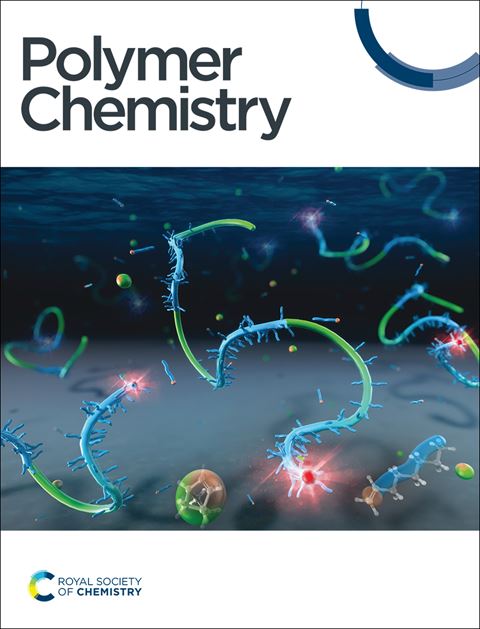水溶性高支枝聚丙烯酸酯的合成:胶体-大分子嵌合体
IF 3.9
2区 化学
Q2 POLYMER SCIENCE
引用次数: 0
摘要
树突聚合物是一种高分子量的枝状大分子,具有规则的、多层分支的拓扑结构,其外围具有高密度的官能团。它们明确的结构,没有交联或环,赋予了粒子-大分子的二元性,在界面上变得特别明显。然而,控制其界面行为的潜在机制在很大程度上仍未被探索。在这里,我们阐明了独特的拓扑结构如何决定水溶性树形聚合物的界面组织。采用单电子转移活性自由基聚合的迭代接枝方法,我们合成了具有控制分支和超高分子量(6.2·10⁶g·mol⁻¹)的窄分散聚合物。在界面吸附作用下,这些聚合物从溶液中的球形刚性颗粒转变为高度柔性的二维构象。通过原子力显微镜观察和耗散粒子动力学模拟证实,在固体界面上,增加节段密度会使表面形态从准二维圆盘转变为煎蛋状结构。在液-液界面,由于聚合物段吸附所产生的能量增益,衬底约束的缺失有助于完全扩散成均匀的二维圆盘。此外,我们发现树形结构固有的大分子拥挤和拓扑约束决定了吸附聚合物层对压缩的响应,与传统柔性线性或星形聚合物的行为形成鲜明对比。高界面活性、空间适应性端基和极端分子柔韧性的结合将使树状聚合物能够适应复杂的界面,作为多价和超选择相互作用的通用平台。这些性质为设计具有协同结合效应的多价纳米载体和自适应界面材料开辟了新的途径。本文章由计算机程序翻译,如有差异,请以英文原文为准。

Synthesis of water-soluble, highly branched arborescent poly(acrylate)s: a colloid-macromolecule chimera†
Arborescent (dendrigraft) polymers are high-molecular-weight dendritic macromolecules with a regular, multilevel branched topology and a high density of functional end groups in their periphery. Their well-defined architecture, devoid of cross-links or loops, imparts a particle-macromolecule duality that becomes particularly pronounced at interfaces. However, the underlying mechanisms governing their interfacial behavior remain largely unexplored. Here, we elucidate how the unique topology dictates the interfacial organization of water-soluble arborescent polymers. Using an iterative grafting-from approach via single-electron transfer living radical polymerization, we synthesized narrowly dispersed polymers with controlled branching and ultra-high molecular weight of 6.2 × 106 g mol−1. These polymers transition from spherical rigid particles in solution, to highly flexible, two-dimensional conformations upon interfacial adsorption. At solid interfaces, increasing segment density shifts surface morphologies from quasi-2D discs to fried-egg-like structures, as observed by atomic force microscopy and corroborated by dissipative particle dynamics simulations. At liquid–liquid interfaces, the absence of substrate constraints facilitates complete spreading into uniform 2D discs, driven by the energy gain due to polymer-segment adsorption. Furthermore, we uncover that macromolecular crowding and topological constraints inherent to the arborescent architecture dictate the response to compression of the adsorbed polymer layer, contrasting sharply with the behavior of conventional flexible linear or star polymers. The combination of high interfacial activity, spatially adaptable end groups, and extreme molecular flexibility will enable arborescent polymers to adapt to complex interfaces, acting as versatile platforms for multivalent and superselective interactions. These properties open new avenues for designing multivalent nanocarriers and adaptive interfacial materials with cooperative binding effects.
求助全文
通过发布文献求助,成功后即可免费获取论文全文。
去求助
来源期刊

Polymer Chemistry
POLYMER SCIENCE-
CiteScore
8.60
自引率
8.70%
发文量
535
审稿时长
1.7 months
期刊介绍:
Polymer Chemistry welcomes submissions in all areas of polymer science that have a strong focus on macromolecular chemistry. Manuscripts may cover a broad range of fields, yet no direct application focus is required.
 求助内容:
求助内容: 应助结果提醒方式:
应助结果提醒方式:


